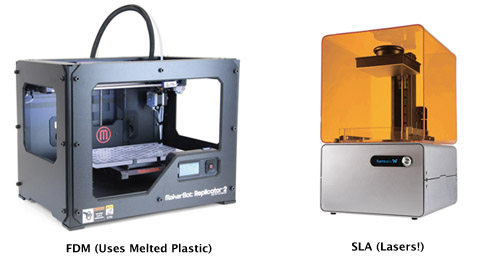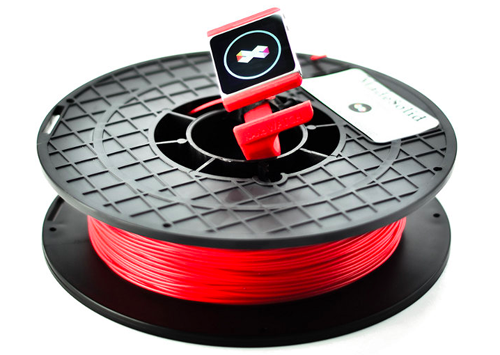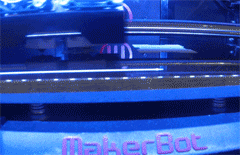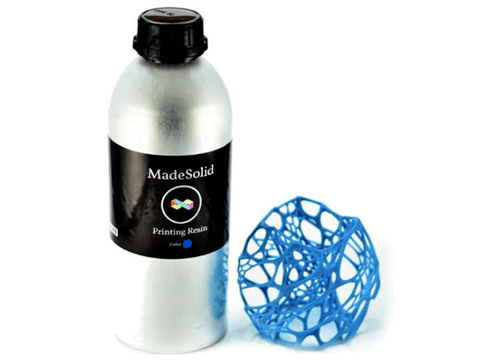It seems like we can’t go a week these days without hearing about some new startup making a new 3D printer that wants to be better and cheaper than everything else. I’m not complaining, of course — competition is good for everyone. But it’s a tough space if you’re looking to stand out.
MadeSolid, a YC-backed company out of Emeryville, CA, is going after the 3D printing market from the other end: they want to fix the materials we 3D print with.
You see, 3D printing isn’t perfect. Amongst other things, the smallest snag in the process of printing an object can (and regularly does) wreck the entire thing — often after many hours of printing. Imagine if you were printing a book on an inkjet printer and the entire thing somehow ruined itself any time there was a paper jam or if a bit of ink ended up in the wrong place. When 3D printers fail, they tend to fail hard.
MadeSolid actually started out with the intention of being a 3D printing service, but quickly realized that the fail rates of 3D printers was just too high for them to do it at scale. With backgrounds in chemistry, nuclear engineering, and business (quite the combination), the company’s three co-founders set out to tackle what they saw as an overlooked weakness: the materials used to 3D print.
A 3D Printing Primer

For those who are just keeping an eye on 3D printing from afar, a quick primer: there are actually quite a few different types of 3D printers. The two types that have become cheap/accessible enough to find their way into the homes of hobbyists are Fused Deposition Modeling (FDM) and Stereolithography (SLA).
Those names may sound a bit intimidating, but this is all you really need to know: FDM printers (like MakerBots) heat up plastic until it melts, then lays that ooey, gooey plastic down layer by layer to form an object. Meanwhile, SLA printers (like the Form 1) aim superfocused lasers into a vat of specialized goop (called a “photopolymer resin”) that hardens almost instantly when the laser makes contact.
Each style of printer has its strengths and weaknesses. Stereolithographic printers tend to be a bit finicky right now, but can make crazy detailed prints. FDM printers have a friendlier learning curve, but the print resolution of a stream of melted plastic just can’t match that of a finely-tuned laser.
So which tech would a company like MadeSolid bet on? Both! While company co-founder Lance Pickens tells me that he sees SLA printers winning out in the long run, the company is hedging their bets and making materials for both types of printer.
PET+

When it comes to plastic extrusion printers like the Makerbot, most folks turn to one of two materials: ABS or PLA.
Neither of these materials is perfect. Printing with ABS makes the entire room smell like straight up cancer; it’s the type of thing that you smell and just know it’s probably not great for you. PLA, meanwhile, smells like waffles (seriously) — but objects printed with it tend to be fairly brittle.
Looking to make a material that offers up the strengths of both, MadeSolid has come up with what they call PET+ — a modified version of the PET material that’s commonly used in manufacturing.
MadeSolid has composited PET+ for a very specific set of properties:
- It’s more flexible than PLA or ABS.
- There’s very, very little shrinkage as the material prints. (Amongst other things, shrinkage makes it harder to keep the base of your 3D object from warping off of the build plate — once that happens, your entire print is generally completely wrecked.)
- It’s recyclable
- It’s heat resistant. You probably don’t want to expose it to flames on the regular (don’t make an oven mitt out of it) — but unlike ABS, it won’t immediately burst into flames, and unlike PLA, it won’t melt in a hot car.
- It’s hydrophobic. Some materials (ABS, Nylon) need to be in air-tight containers when stored for long periods of time to avoid absorbing airborne water that’ll cause printer jams; PET+ doesn’t.
- It’ll work with or without a heated build plate
I’ve been tinkering with a spool of PET+ for a few days now, and I’m quite pleased with it so far. Like any material, it has its quirks (it’s very similar to PLA, in the quirks it does have), but I’m really enjoying working with it.

Unlike ABS or PLA, it smells like… nothing. Really — even when I close my doors and let the printer run for a while, I don’t detect any fumes. That’s not to say you should stand over your printer and huff at it all day (detectable fumes or not, the jury is still out on how safe 3D printer emissions are), but it won’t drive you out of the room.
In two dozen or so prints, I’ve yet to have a single one fail for any reason that I could blame on the material (as opposed to a software or printer glitch.) I’ve seen next to no shrinkage/warping, and not one print has detached from my build plate (heated to 60c)
MS Resin:

As mentioned, MadeSolid is making materials for SLA printers, too. As with PET+, they’ve custom tailored their resin to fix what they didn’t like about the stuff already on the market:
- It’s less viscous than most other resins, making it easier to clean things up post-print.
- It comes in multiple, bright colors: black, white, pink, and blue. Many of the resins on the market are limited to such exciting hues as “clear”, “white”, and “grey”.
- It comes out of the printer with a rather neat soft-touch, matte finish.
You can find out more about MadeSolid here. These guys have only been around for a few months — I’m excited to see what they’ll do in a year.
Oh, and be sure to check out the video up top which MadeSolid put together to show how their stuff fares against the rest (if only for that sweet, sweet blowtorch action at the end).